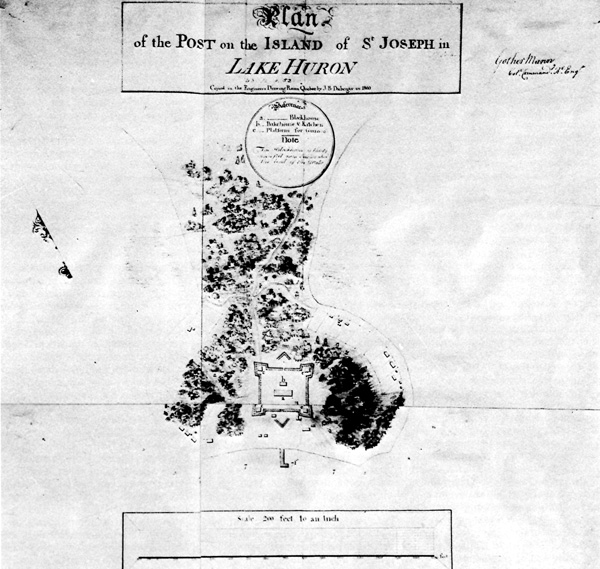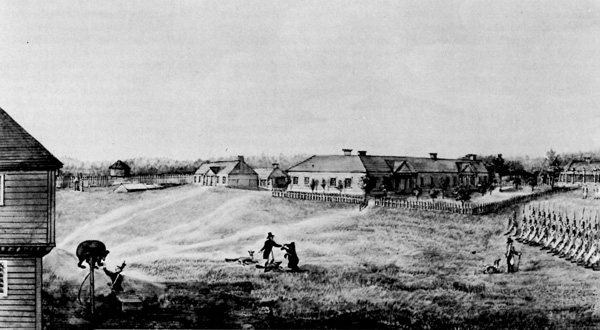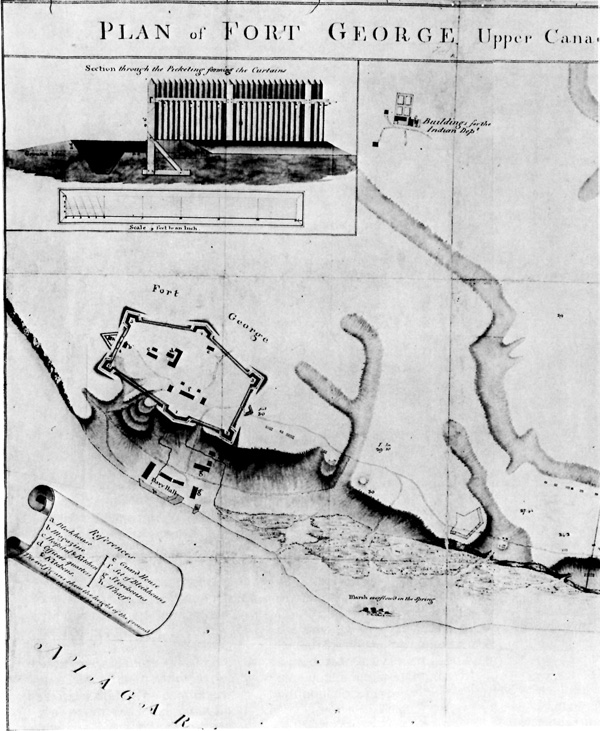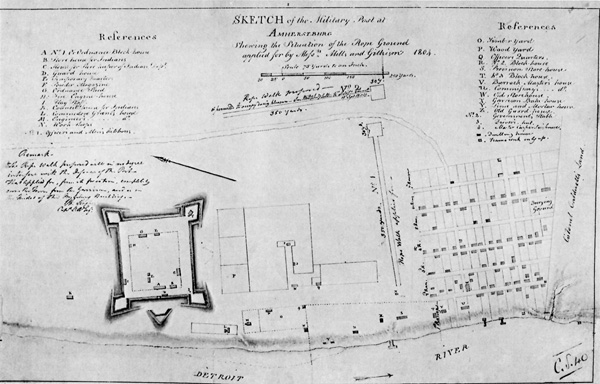|
|
 |
Canadian Historic Sites: Occasional Papers in Archaeology and History No. 14
The British Indian Department and the Frontier in North America, 1755-1830
by Robert S. Allen
The Quiet Years (1796-1807)
I
The signing of the Treaty of Greenville in 1795 and the evacuation
of the western posts in 1796 had unquestionably reduced the influence
and effectiveness of the British Indian Department among the tribes of
the Northwest. The disgruntled and starving Indians, who had been unable
to hunt or plant corn for the past two years as a result of the military
campaigns, spent the harsh winter of 1795-96 at Swan Creek, on the north
side of the Maumee River near present Toledo, Ohio, and were
provisioned by the Indian Department from the king's stores at Detroit.
Alexander McKee and other officers from the service hoped that in the
spring of 1796 the Indians could be induced to move north into Canada
and settle at Chenail Ecarté, an area 12 miles square just north of Lake
St. Clair.1
The removal of the tribes from the United States was a slow and
disappointing process; however, the British Indian Department wanted the
Indians to be relocated by spring in time for planting and thus reduce
the cost of the enormous consumption of provisions.2 But the
Indians were tardy, and the delays continued until several chiefs
finally offered the excuse that they had planted corn at Swan Creek and
wished to remain at that location in order to harvest the crop. Clearly,
most of the Indians did not want to leave their ancient homelands in
spite of the fact that the political authority for the future of native
survival in the Ohio valley was now vested in the hands of their recent
and hated enemies, the Americans. Instead of the expected exodus of
thousands, only a few hundred Indians eventually migrated to the
supposed sanctuary of British North America. In July some of the
Shawnee under Captain Johnny and Blackbird moved to Bois Blanc Island in
the Detroit River, opposite the grand home of Matthew Elliott. But it
was not until 1797 that scattered bands finally trekked to Chenail
Ecarté.3

21 The post at St. Joseph, a British
Indian Department centre on the upper lakes, 1800.
(Public Archives of Canada.)
|
With the American takeover of Niagara, Detroit and Michilimackinac in
the late summer of 1796, the British Indian Department was faced with
the new, if less formidable, task of managing Indian affairs during the
few quiet years of peace. The surrender of the disputed western posts
prompted a reduction of British military forces in Upper Canada, as an
era of Anglo-American friendship was seemingly assured. Only 500 men of
the Queen's Rangers and Royal Canadian Volunteers4 were left
to garrison Kingston, York and the replacement forts that were to be
constructed in Canadian territory: Fort George at Newark on the west
bank of the Niagara River; Fort Malden at Amherstburg on the Detroit
River, and Fort St. Joseph, on the island of the same name at the mouth
of the Saint Marys River.5
The re-location of the military garrisons and the construction of new
posts as well as the termination of the long war with the United States
for control of the Ohio valley necessitated a complete reorganization of
the British Indian Department. At the request of Lord Dorchester,
Alexander McKee devised a "Plan for the Future Government of the Indian
Department" in June, 1796. In his report, the deputy superintendent
general stressed the importance of continuing to employ the officers of
the department to "use the utmost diligence to preserve and promote
friendship between the Troops and the Indians. . .,and to maintain
harmony at the King's [new] posts."6 He also suggested that
in addition to the usual employment of departmental storekeepers, clerks
and interpreters, three superintendents of Indian affairs should be
appointed, one for each of the replacement forts. As a result McKee
recommended his son Thomas as superintendent for St. Joseph, Matthew
Elliott for Fort Malden, and William Claus, a grandson of Sir William
Johnson, for Fort George.7 Just prior to his departure for
England, Lord Dorchester approved the appointments, and the British
Indian Department, thus restructured, assumed its new role of managing
Indian affairs.
In June 1797 at St. Joseph, Alexander McKee and his son Thomas met
with Ottawa and Ojibway to negotiate the purchase of the island which
"the Indians readily agreed to," and to attempt to curb the traditional
intertribal warfare between the Sioux and the Ojibway.8 The
Indians promised to visit and trade at the new British post and
"appear[ed] to be friendly as usual."9 Captain Peter
Drummond, the commandant at St. Joseph, seemed content with the
situation and noted with enthusiasm that the construction of the
barracks and the buildings for the British Indian Department were
progressing smoothly.10 But the attitude of the British
military after Greenville was that the Indians should be abandoned to
their own devices, as there would be no future need for their
assistance. The new object of the government, observed Thomas McKee, was
"to have as few Indians to come to the Posts as possible in order to
lessen the expenditure of Provisions."11
II
The peacetime policy added new complications to the general
administration of the Indian Department in Upper Canada. Since 1775 the
department had faced continuous crises, and as a result great freedom
had been bestowed on the various agents in regard to obtaining
provisions and gifts for the British Indian allies. But for a decade
after 1796, a period of comparative tranquility existed in the
Northwest, and this meant the return to a rigid routine and the strict
accounting of goods. To compound the situation the expenses of the
Indian Department were defrayed from the army budget, and this created a
definite cause for future friction. The old, irritating problem of
military jurisdiction and authority in the affairs of the Indian
Department was to reach a climax in the McLean-Elliott feud at Fort
Malden in 1797.
As early as 1795, the department had been accused of depredations.
Joseph Brant noticed that "Goods intended for the tribes [were] often
not received. . . . The Enormous expense of which much seems to
disappear before getting to the Indian country."12 Lieutenant
Governor Simcoe argued that the apparent unpopularity of the Indian
Department arose "from the changes of peculation and from the belief
that the officers of the Department foment ill will between the Indians
and the United States."13 He further considered the
department as" an Establishment not only incompetent and dangerous as
far as concerns foreign nations, but to be too extensive in its
objects."14
These charges of pillage resulting in personal profit were not mere
speculation or unfounded, particularly in the case of Matthew Elliott.
In the autumn of 1796, traveller Isaac Weld estimated the size of
Elliott's estate at the mouth of the Detroit River as 2,000 acres, a
very large part of which was cleared and "cultivated in a style which
would not be thought meanly of even in England."15 The house,
Weld stated, was the best in the whole district, and situated 200 yards
from the river, the parlor windows afforded an excellent view of the
Indian canoes passing and repassing before Bois Blanc
Island.16 Elliott used his farm as his Indian agency, and
with the assistance of his storekeeper and clerk, George Ironside,
exercised control of Indian affairs in the region. Alexander McKee had
retired to his home on the nearby Thames River, and from there directed
a general supervision of Indian affairs in Upper Canada.
The affluent life-style of Elliott and his customary liberality of
goods toward the Indians, for which the army had to account, soon began
to annoy the military at Malden who had been ordered to economize. In
return the Indian Department was disgusted at the action of the British
officers who had agreed to lend 50 barrels of pork to the Americans at
Detroit in the autumn of 1796 when supplies for the Indians appeared
scarce. The problem of the distribution of supplies to the Indians was
acute now that peace had come to the Northwest. The basis of the
difficulty was that the military held the purse-strings and the Indian
Department the power in regard to the Indians. To ensure that an
accurate account of provisions and gifts could be maintained, the
military decided that their officers should be present on each occasion in
which Indians received goods. But small parties of Indians were
constantly arriving to proclaim their loyalty to the British king and to
receive gifts, as was the tradition. Since Elliott's farm was more than
one mile from the British officer's quarters at Fort Malden, it was
impossible for army representatives to be present at every occasion.
The commandant at Fort Malden (Amherstburg), Captain Hector McLean,
initiated the feud in a letter of complaint to James Green, the military
secretary at Quebec. After discussing the details of the construction of
several buildings at the new post, McLean commented on the expenses of
the enormous consumption of provisions by the Indians, and thought that
the high costs could be checked without the least detriment to the
Indian service.17 McLean had hoped that the presence of
officers during the distribution of goods would curb any excesses by the
Indian Department. But Elliott refused to detain various Indian
dignitaries in order to accommodate the army. This action prompted
McLean to write two long letters to Green, in which the commandant
accused the Indian Department of carelessness and lack of formality.
McLean was astonished at the consumption of provisions and suggested as
a remedy the gradual diminishing of the issue of provisions to the
Indians, and that native visits to the post should be made less
frequently. "I have reason to believe that their coming in so often is
encouraged by Mr. Elliott."18 McLean further objected to the
fact that the government had to pay Elliott £160 per year for
storage, because the Indian stones were kept at his farm and not at the
garrison. In addition, since the farm was over a mile away, the officers
found it inconvenient to attend every delivery of presents, particularly
when such short notice was given and generally at the dinner hour. Also,
the distance, argued McLean "renders the peculation the more easy,
and detection less so."19 Finally, the commandant delivered a
scathing denunciation of Elliott.
He lives . . . in the greatest affluence at an expense of above a
thousand a year. He possesses an extensive farm not far from the
garrison stock'd with about six or seven hundred head of cattle &
. . . employs fifty or sixty persons constantly about his house &
farm, chiefly slaves. . . . How his wealth had been accumulated, . . .
is well known.20
Matthew Elliott, confident of the power of the Indian Department,
appeared unperturbed at these verbal attacks and smugly continued the
feud with McLean by issuing provisions to Indians, often in the absence
of the army officers from Malden. But a week after the explosion
regarding provisions, McLean uncovered another aspect of Elliott's
activities—the supposed peculation of bread. The normal practice in
securing bread for the Indians was to have Elliott send a requisition to
the commanding officer at the fort for a specific amount. With the
signing of the order form, Elliott would despatch his servants to the
garrison bakery to obtain the bread. However, McLean noticed that
Elliott's negro slaves were picking up some 20 to 25 loaves per day.
Apparently Elliott was getting free bread for himself and his large
household staff from the garrison bakery under the pretext of acquiring
it for the Indians. The commandant immediately ordered the commissary
not to charge any bread to the government account unless delivered
directly to the Indians for their own use.21

22 Fort George, Niagara River, one of the three
main British Indian centres in Upper Canada. Sketch by James Walsh,
about 1804.
(William L. Clements Library, Ann Arbor,
Michigan.)
|
The irregularities in the Indian Department under Elliott at Fort
Malden were exposed for the third time over the requisition for goods to
supply the Indians at Chenail Ecarté during the winter of 1797-98.
Elliott requested supplies for 534 Indians, but McLean received a return
of Indians at Chenail to the number of 160 from Lieutenant Fraser, whom
the commandant had sent to check the actual numbers.22 The
principal chief at Chenail, Chief Bowl, supported Fraser's figures. The
false return of Indians by Elliott and the mounting bitter feud with
McLean over provisioning and obtaining bread from the garrison bakery
finally provoked the governor-in-chief, Robert Prescott, to dismiss
Matthew Elliott as Superintendent of Indian Affairs at Fort Malden in
December, 1797.23 Thomas McKee was appointed to succeed
Elliott.
The McLean-Elliott feud reflected the new policy of order and
regulation so beloved by the peacetime army. Elliott, who had served
the Indian Department faithfully for nearly 20 years in times of crisis,
undoubtedly did not realize that the power of the department during the
quiet years was to be curtailed, and that a rigid enforcement of
regulations had replaced the more usual practice of laxity in which the
attainment of a degree of personal profit was not considered
unwarranted. Dismissed without the benefit of a proper investigation, Elliott
became in effect the scapegoat for the common peculiarities of the Indian
Department in Upper Canada. His conduct was not unlike that of most of
the other members of the department, notably McKee. For the next 10
years Elliott was preoccupied with attempts to clear himself and obtain
reinstatement.
III
In addition to the peace negotiation with the upper lakes tribes at
St. Joseph and the unfortunate Elliott scandal at Fort Malden, the
Indian Department was confronted with another type of problem in the
form of a dispute with Joseph Brant over the sale of the Grand River
lands. The Haldimand grant of 1784 had provided the Iroquois with a
"fertile and happy retreat" on the Grand River as a substitute for the
loss of their traditional homelands in New York during the American
Revolution. But by 1796 less than 2,000 Iroquois, mostly Mohawk, had
taken advantage of the opportunity to live on this large tract of about
570,000 acres. This discouraging situation was compounded because of the
gradual yet steady advance of white settlement in Upper Canada which
began to surround the reserve. Game became scarce in the Grand valley,
and Iroquois repugnance at being reduced to the status of yeomen
resulted in economic depression for the Indians at Grand River.
In an apparent effort to alleviate the Indians' plight, Joseph Brant
devised a plan whereby the future welfare of the Grand River Iroquois
could be assured. The Mohawk leader rationalized that the sale of large
sections of the reserve to British and American purchasers would provide
the native people of the Grand valley with a sufficient fund for their
future needs. The argument was convincing because such a large area was
not needed by the Indians who were indifferent to cultivating the land.
As a successful step in achieving his aims, Brant acquired the power of
attorney in 1796 to sell the Indian lands along the Grand River, and
this power was acknowledged and signed by 35 chiefs of the
confederacy.24 To finalize the business transactions, Brant
held a large council with William Claus, superintendent of Indian
affairs at Fort George, in November, 1796, at which the Mohawk
entrepreneur argued for a legal deed to the Grand River lands of the
Iroquois.25 Brant contended that the Haldimand grant of 1784
not only constituted the creation of an estate in fee simple for the
Indians, but recognized the Iroquois confederacy as a distinct nation,
competent to arrange its own affairs with other sovereign states such as
Great Britain and the United States.26
William Claus and the Indian Department, representing British
interests, countered that the Six Nations, Brant's arguments
notwithstanding, did not enjoy the status of a sovereign nation.
Haldimand's actions, replied Claus, should not be construed as the
authority to dispose of Indian property without the king's approval.
Indeed, the question of the sale of Indian lands had been settled by the
royal proclamation of 1763, which stated in part:
And whereas great Frauds and Abuses have been committed in
purchasing Lands of the Indians to the great Prejudice of our Interests
and to the great Dissatisfaction of the said Indians; . . . to prevent
such Irregularities for the future, and to the end that the Indians may
be convinced of our Justice and determined Resolution to remove all
reasonable Cause of Discontent, We . . . require, that no private Person
do presume to make any Purchase from the said Indians of any Lands
reserved to the said Indians, within those parts of our Colonies where,
We have thought proper to allow Settlement; but that, if at any Time any
of the said Indians should be inclined to dispose of the said Lands, the
same shall be Purchased only for Us in our Name.27
Although the proclamation acknowledged the validity of Indian land
title, or native rights of prior occupancy, it did not accept the idea
of Indian sovereignty overall lands not formally surrendered to the
king.
The reply of Claus infuriated Brant who argued in vain that the
Iroquois could no longer survive exclusively on hunting, and that their
only recourse was to sell parts of the grant so they might obtain some
form of financial relief. The debate continued for months and grew
increasingly bitter. By June, 1797, wild rumours were spreading in Upper
Canada that the Iroquois were angry because they could not sell their
lands on the Grand River and that they might raise the hatchet in
retaliation against the king's subjects. Further unconfirmed information was
received that the French and Spaniards were planning an invasion of
Upper Canada from the Mississippi.28 In response to these
alarms, and following the earlier instructions of the Duke of Portland
of the Home Department, Lieutenant Governor Peter Russell held an
important meeting with his executive council at Government House in
York. The board unanimously agreed to capitulate to Brant's demands
provided that the Indians formally transferred to the crown their
"interest" in those Grand River lands which they wished to sell. The
Indians readily agreed to this proviso and the transfer was arranged by
February, 1798.29 In return the crown sold the designated
tracts, approximately 352,000 acres, to the various individual white
purchasers with whom Brant was dealing. Although Brant insisted that he
was acting on behalf of his people, his personal wealth was
considerably augmented as a result of the sale, and in later years the
Indian Department noted the destitute condition of the Grand River
Indians.30
IV
With the exception of the McLean-Elliott feud and the controversy
over the sale of the Grand River lands, the Indian Department in Upper
Canada experienced an unusual period of quiet between the years 1796 and
1807. At St. Joseph, in March of 1798, Peter Drummond requested
£1,700 worth of presents for the Indians who appeared to have
completely adapted to the British change over from
Michilimackinac;31 and at Fort Malden, McLean wrote lengthy
despatches outlining the stages of development of the new post and of
the building and construction of the Indian Department storehouses and
council house.32 About a year after the dismissal of Elliott,
Governor Prescott produced a return of issued provisions for 1797 and
1798 at Amherstburg and Chenail Ecarté. The figures showed a saving in
1798 (the year Elliott was no longer with the department) of 21,000
rations of provisions, 1,000 gallons of rum and 71,000 bushels of corn,
amounting to upwards of £3,000, and that the Indians had actually
received more in 1798 than in the year before.33 This
inventory sealed the already damaged career of Matthew Elliott for many
years.

23 Structural plan, Fort Goerge,
1799. Note British Indian Department buildings, upper centre.
(Public Archives of Canada.)
|

24 Fort Malden (Amherstburg), 1804,
another of the main British Indian Department frontier
posts. Note B and C, storehouse and building for
Indian Department.
(Public Archives of Canada.)
|
The next few uneventful months were soon shattered on 15 February
1799 by the death of Alexander McKee at his home on the Thames River.
His passing initiated a distasteful dispute as to whether the patronage
of the Indian Department should be under civil or military control. In
Halifax, the Duke of Kent, commander-in-chief of all his majesty's
forces in North America, appointed Colonel John Connolly as successor.
But the new lieutenant governor of Upper Canada, Peter Hunter, supported
by Sir John Johnson in Montreal, argued for William Claus. During the
interim J. Baby, A. Grant and Thomas McKee were appointed as temporary
administrators of the Indian Department until further
orders.34 Hunter Johnson and other senior officials of the
department insisted that the new deputy superintendent general must be,
like Claus, a man of considerable ability and experience regarding
Indian affairs. The choice of Connolly, they maintained, was cleanly
political, and his appointment was unwise because a lack of training and
knowledge in the tactful art of Indian affairs could seriously
jeopardize His Majesty's Indian interests in the Northwest.35
Opinions were exchanged for more than a year until 24 July 1800 when
William Claus was finally accepted and appointed as colonel and deputy
superintendent general. He held the position with honour and skill until
his death in 1826.
With the appointment of William Claus the Indian Department settled
back into the interminable tedium of Indian councils, gift giving, and
pledges of British friendship. At Fort Malden, McLean decided that a
reduction of the costly Indian presents would be desirable, particularly
since the Americans were not pouring out supplies on attempting to
detach the tribes from the king's interest.36 Thomas McKee
opposed the reductions and regarded the distribution of gifts as vital.
If the traditional policy was not continued, he cautioned, it "may
operate to the diminution, if not the total extinction of our influence
and may infinitely prejudice H. M's Indian Interest in these
parts."37 The wisdom of McKee's advice was to be revealed
later.
By the end of 1800 the years of friendly Anglo-American relations and
an indifference toward the Indians produced a detached and relaxed
attitude on the part of the British army in Upper Canada. The
distribution of forces38 illustrated the apparent lack of
concern for defence:
Kingston 102
York 143
Fort George 243
Fort Malden 118
St. Joseph 38
For the Indian Department, the major concern continued to be the
Grand River lands. In three major councils at Fort George in 1803, 1804
and 1806, the Iroquois argued relentlessly for their legal right to
lease more and more of their lands in order to gain a financial redress
from poverty.39 But, although the Northwest and frontier of
Upper Canada were quiet, relations between Great Britain and the United
States at sea were rapidly deteriorating after 1803. With the renewal of
war in Europe, the British government adopted a maritime policy which
seriously damaged the commercial shipping of neutral nations.
Confiscation of cargoes and impressment produced a wave of anti-British
feeling in the United States, with demands by an aroused American
public for a redemption of national honour.
|

